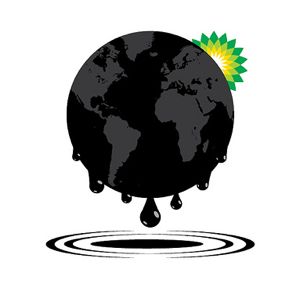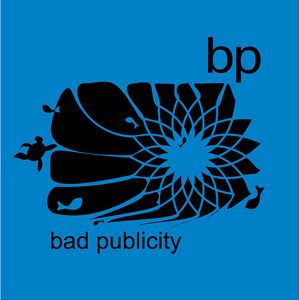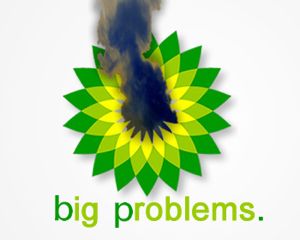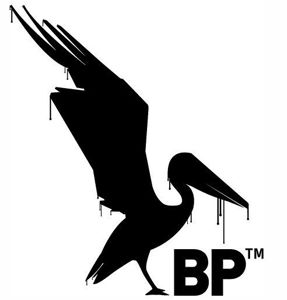BP’s Image Problem
Air Date: Week of June 11, 2010

Entry from Greenpeace's "Behind the Logo” design competition. (Greenpeace UK)
BP has spent hundreds of millions of dollars to re-brand itself as a green company in recent years. Now the public is making a mockery of the eco-friendly brand as the gulf spill makes it clear BP is not 'beyond petroleum’ at all. Host Jeff Young asks media analyst John Carroll if BP's image can survive the PR disaster.
Transcript
YOUNG: It’s Living on Earth, I’m Jeff Young. Nine years ago British Petroleum had an extreme makeover. It became ‘Beyond Petroleum’ and sported a friendly, green and yellow design, something somewhere between a starburst and sunflower. Now that cheerful logo is a big, fat target for protest art. Thousands of new BP designs dripping oil are flooding the internet. Boston University professor and media analyst John Carroll says BP has lost control of its own public identity.

Entry from Greenpeace's “Behind the Logo” design competition. (Greenpeace UK)
CARROLL: Well you’ve got two things going on here, two elements they’re taking off on. One is the name, so you’ve got BP turning into “biggest polluter,” or “big problem,” or “burst pipes.” And then you’ve got the image of the logo. So all of a sudden you’ve got a globe covered with oil, you’ve got pelicans covered with oil. I mean one of them is a remake of the famous Eddie Adams Saigon execution photo from the Vietnam War. And, it’s a gas pump held to somebody’s head and he’s being shot with it. It’s extremely powerful, but all of them have some sort of damning impact on BP.

Entry from Greenpeace's “Behind the Logo” design competition. (Greenpeace UK)
YOUNG: And the irony here is they put a lot of money into making that logo so immediately recognizable.
CARROLL: They certainly did. They spent about $100 million a year for the last few years promoting their brand as environmentally conscious. And BP had done a good job, by some measures they had a very positive brand image. And this is important when you wind up in a crisis situation because the stronger your brand image, the more possible it is to weather these kinds of environmental disasters, and also publicity disasters.
YOUNG: How have companies faced with big PR challenges dealt with this in the past, and can BP look to them and rescue their image here?
CARROLL: Well the textbook case of how to address a crisis like this is Tylenol from 1982. They went out and spent $300 million repairing their brand image and they built their market share back up because they were able to go out and control the message. The big difference now for BP is they can’t control the message.

Entry from Greenpeace's “Behind the Logo” design competition. (Greenpeace UK)
Advertising used to be this one-way street, now it’s a two way street, it’s a conversation. You don’t create your brand anymore. You collaborate with consumers to create your brand. In good times that’s terrific, in tough times that becomes an obstacle that’s very hard to overcome.
YOUNG: There’s a faux BP Twitter account out there that is wildly successful.
CARROLL: It’s got 130,000 followers and counting. While BP’s own Twitter page has 12,000 followers. So that’s one indication of what happens. And You Tube for instance, there’s Typhoid Tony Hayward, the CEO of BP, who has to be the worst spokesman since Chemical Ali over in Iraq.
I mean this guy puts the damage in damage control. He has, his TV spot up on YouTube, it’s been viewed by 160,000 people- the Explainer on Al-Jazeera has been viewed by 1.6 million people. So BP finds itself in this situation where A) nobody believes a word they say, B) reality trumps PR every time, and C) they can’t control their message even if the first two weren’t in effect, because there are too many competing voices out there.
YOUNG: You know one thing I noticed recently is if you do a simple Google search or Yahoo search and you enter “oil spill,” the first thing you see at the top is something BP paid to be there. That’s I guess their way of fighting back? They’ve apparently bought the search term?

Entry from Greenpeace's “Behind the Logo” design competition. (Greenpeace UK)
CARROLL: Yes they have and they paid a premium for it, too. I saw one piece that said they’re paying up to $6 a click. There’s something Orwellian about it, but it’s all part of the game. But a lot of times it just isn’t enough. Because the wave of bad publicity keeps coming out, like the wave of oil that keeps coming out underwater. I mean when you have a website that just shows oil coming out of your leaking well 24 hours a day, I mean it’s very hard to come up with an image that counters that.
YOUNG: Is this the end of that re-designed BP logo? Do you think that can survive this, or is that history?
CARROLL: I think that they’re gonna have to make a decision. Have they lost control of that to an extent that they need to go and completely re-tool their image? Anything they do at this point creates a problem with them because they can’t trump reality. I mean, they’ve got Tony Hayward in a TV spot with pristine beaches behind him, and all it does is remind people that those beaches are not going to look that way for very long.
YOUNG: If you were in BP’s PR team, would you say “We’ve got to get rid of Mr. Hayward, he’s gotta go.”

Entry from Greenpeace's “Behind the Logo” design competition. (Greenpeace UK)
CARROLL: I would. I’m usually not in the business of creating ads for other people, but I would certainly consider putting some workers in the ads to say, “We’ve lost 11 of our co-workers, this is devastating to us, and we will do everything we can to make sure that something like this doesn’t happen again.”
The human element is something that they could possibly use to their advantage, at least to convince people that there’s some sincerity, and there’s some humanity behind what they’re doing.
YOUNG: So this is having some, I’m sorry for the pun, spill-over effects. In the world of baseball, batting practice is BP, and now that, even that, is sadly tainted.
CARROLL: Yeah apparently down in the Florida state league, the Brevard County Manatees have decided that they don’t want to take batting practice anymore because they refer to it as BP. So now they take “hitting rehearsal” which is a little like the Freedom Fries from back at the beginning of the Iraq war.
YOUNG: (laughs)
CARROLL: But that’s how far it goes. Big things, small things, they all add up, and they reach this sort of crescendo that’s almost impossible to control, and almost impossible for BP to get its voice above.
YOUNG: Media analyst John Carroll at Boston University. He also blogs at campaignoutsider.com. Thanks very much.
CARROLL: Thank you, Jeff.
Links
Boston University, Communication Studies
Living on Earth wants to hear from you!
Living on Earth
62 Calef Highway, Suite 212
Lee, NH 03861
Telephone: 617-287-4121
E-mail: comments@loe.org
Newsletter [Click here]
Donate to Living on Earth!
Living on Earth is an independent media program and relies entirely on contributions from listeners and institutions supporting public service. Please donate now to preserve an independent environmental voice.
NewsletterLiving on Earth offers a weekly delivery of the show's rundown to your mailbox. Sign up for our newsletter today!
 Sailors For The Sea: Be the change you want to sea.
Sailors For The Sea: Be the change you want to sea.
 The Grantham Foundation for the Protection of the Environment: Committed to protecting and improving the health of the global environment.
The Grantham Foundation for the Protection of the Environment: Committed to protecting and improving the health of the global environment.
 Contribute to Living on Earth and receive, as our gift to you, an archival print of one of Mark Seth Lender's extraordinary wildlife photographs. Follow the link to see Mark's current collection of photographs.
Contribute to Living on Earth and receive, as our gift to you, an archival print of one of Mark Seth Lender's extraordinary wildlife photographs. Follow the link to see Mark's current collection of photographs.
 Buy a signed copy of Mark Seth Lender's book Smeagull the Seagull & support Living on Earth
Buy a signed copy of Mark Seth Lender's book Smeagull the Seagull & support Living on Earth

